As we move from one season to another, predictably the daily ambient temperatures change. As the sun is the major driver of climate, it’s position in the sky throughout the year will dictate local temperatures. The sun goes through known cycles and that sequence ,coupled with other factors that come into play, determines that every season is not the same. That is some summers are hotter than others. Even that being the case, generally you can go to bed assured that average summer temperatures will be higher than average winter temperatures in any location. 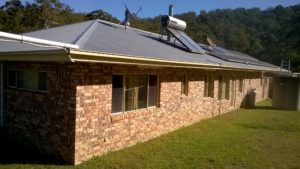 In the previous article, “The Advantages of Living In An Energy Efficient Home Part 1”, it was shown that on the winter solstice, that is, the shortest day of the year, a well-designed and orientated home will allow the northern sun to flood into the home.
In the previous article, “The Advantages of Living In An Energy Efficient Home Part 1”, it was shown that on the winter solstice, that is, the shortest day of the year, a well-designed and orientated home will allow the northern sun to flood into the home.
See Pic 1. On the summer solstice, exactly the opposite condition is the most desirable and in a well-designed and orientated home that can be very easily achieved as shown in Pic 2. Both photos were taken at midday Pic 1 on the winter solstice and Pic 2 on the summer solstice. The summer solstice is the longest day of the year and the sun reaches its highest point in the sky. As illustrated, the changing of the sun’s path can be used in a well-designed home to allow or deny access to the northern wall of the home from season to season. Where we live, which is about an hour north of Brisbane in Queensland Australia, we have experienced temperatures over 40 degrees Celsius during the summer months. It is therefore not desirable to allow the sun access to any window during this time of the year.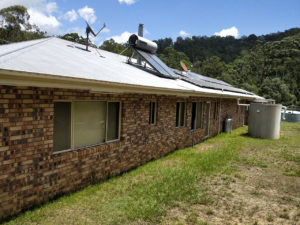
Covering the windows, thereby denying the sun access during the summer months is a strategy to reduce lifting heat levels in a poorly designed home. In a well-designed and orientated home this can happen automatically as seasons come and go. As winter is left behind and the seasonal conditions move closer to summer, the sun has more of a southerly aspect as it rises and sets on each progressive day. This means that the sun is up earlier as summer approaches and rises to a higher point in the sky each day until the summer solstice. It also sets later in the west with a more southerly aspect. This results in progressively longer days, that is, there are more daylight hours offering a residence more exposure to sunshine for a longer period of time until the summer solstice. After the solstice, the suns path reverses these extreme southerly aspect during sunrise and sunset. (In the northern hemisphere the exact opposite occurs where the suns has more of a northerly aspect as the summer solstice approaches reducing until the winter solstice)
Because the path of the sun is very predictable, we can very accurately calculate, even centuries ahead, what time it will rise and set in any given location on the surface of the earth. We also know how high it will rise in the sky in any given location on any given day. This knowledge allows us to design and construct a home that will predictably allow the sun to access the home during the winter but be denied access during the summer.
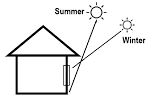 If possible a rectangular home is easily made more energy efficient if the longer sides of the home are parallel with the equator. In climate zones that may experience greater temperature fluctuations from season to season this is more desirable. A home located on the equator would not experience ambient seasonal fluctuations as great as a home located either further north of the equator or further south of the equator. A number of factors contribute to a climate zone’s temperature fluctuations including the distance from the Equator, the height above sea level and other factors including topography. Our home is located 27 degrees south of the equator. The latitude of our home dictates the best roof angle for our home for the mounting of a solar hot water system or photovoltaics (solar panels). True north at our location is approximately 11 degrees east, that is to say, magnetic north and true north are not always the same but to get the best performance from an energy efficient home, a rectangular dwelling must have the longest sides of the home parallel with equator so building to true north is building to cater for the true path of the sun.
If possible a rectangular home is easily made more energy efficient if the longer sides of the home are parallel with the equator. In climate zones that may experience greater temperature fluctuations from season to season this is more desirable. A home located on the equator would not experience ambient seasonal fluctuations as great as a home located either further north of the equator or further south of the equator. A number of factors contribute to a climate zone’s temperature fluctuations including the distance from the Equator, the height above sea level and other factors including topography. Our home is located 27 degrees south of the equator. The latitude of our home dictates the best roof angle for our home for the mounting of a solar hot water system or photovoltaics (solar panels). True north at our location is approximately 11 degrees east, that is to say, magnetic north and true north are not always the same but to get the best performance from an energy efficient home, a rectangular dwelling must have the longest sides of the home parallel with equator so building to true north is building to cater for the true path of the sun.
As the sun begins to ascend higher in the sky each day from the winter solstice to the summer solstice, the eaves on a cleverly built home will allow less and less sun access each day until the sun is totally denied access to the northern wall on the summer solstice. Pic 3. To calculate the necessary eave sizes required to deliver the best thermal performance of a home from season to season at any location, factors including locational latitude and ceiling height are put into a formula. I have said many times before that. “ a home’s thermal performance is determined well before it is ever built”.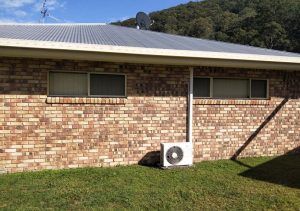 In the southern hemisphere, the sun spends most of its time in the north of the sky. In the northern hemisphere the opposite will be true. At the location of my family’s home, in the summer months, the afternoon sun, preparing to set in the west, will have more and more of a southerly aspect each progressing day as the summer solstice is approached. Where necessary, and especially where extreme temperature fluctuations are experienced, any undesired effects of this increased daily southerly aspect and exposure may need to be addressed. Planting deciduous trees strategically to the south-east or the south-west of a home in such a location allows the leaves on the trees to block the hot morning and afternoon summer sun but allows the sun winter access as the leaves have fall off seasonally. In the southern hemisphere, sun access to the northern wall is the major key to be factored in any design that addresses passive energy efficiency. For those living in the northern hemisphere, it is the southern wall that requires protection from the summer sun.
In the southern hemisphere, the sun spends most of its time in the north of the sky. In the northern hemisphere the opposite will be true. At the location of my family’s home, in the summer months, the afternoon sun, preparing to set in the west, will have more and more of a southerly aspect each progressing day as the summer solstice is approached. Where necessary, and especially where extreme temperature fluctuations are experienced, any undesired effects of this increased daily southerly aspect and exposure may need to be addressed. Planting deciduous trees strategically to the south-east or the south-west of a home in such a location allows the leaves on the trees to block the hot morning and afternoon summer sun but allows the sun winter access as the leaves have fall off seasonally. In the southern hemisphere, sun access to the northern wall is the major key to be factored in any design that addresses passive energy efficiency. For those living in the northern hemisphere, it is the southern wall that requires protection from the summer sun.
Because a number of factors were considered in our home’s design, we elected to fit smaller and higher windows on the eastern side of our home. This still allows air movement and winter sun exposure but reduces the heating of the internal ambient temperature in our home during the summer. See Pic 5 As we are reasonably close to the beach we get a maritime effect which levels out extreme temperature fluctuations however our closeness to the equator still affords high temperatures during summer. The design of our home is rectangular with the smaller ends facing true east and west. The longer sides of the home afford sun protection by design from the eaves on our northern side however as the sun sets its altitude reduces and eaves on the western wall cannot shield the home from the onslaught of the western/afternoon sun in the warming months. 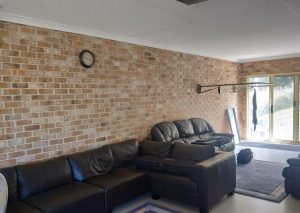 To address this anticipated issue, we elected not have any windows on the western wall. Pic 5. In our double brick home, the inner bricks on our western wall are separated from the outside ones by an insulating air cavity which are only exposed to the radiated heat from the back of outside bricks. The internal ambient temperature is always that of the internal bricks and floor which is tiled concrete. This “thermal mass” (heavy building materials ie bricks and concrete, store and absorb heat) stabilizes the internal temperatures of our home and reduces the greater temperature fluctuations inside our home that may be experienced in other dwellings. Knowing the sun’s path and using that knowledge to thermally benefit in a dwelling is only one advantage of living in an energy efficient home.
To address this anticipated issue, we elected not have any windows on the western wall. Pic 5. In our double brick home, the inner bricks on our western wall are separated from the outside ones by an insulating air cavity which are only exposed to the radiated heat from the back of outside bricks. The internal ambient temperature is always that of the internal bricks and floor which is tiled concrete. This “thermal mass” (heavy building materials ie bricks and concrete, store and absorb heat) stabilizes the internal temperatures of our home and reduces the greater temperature fluctuations inside our home that may be experienced in other dwellings. Knowing the sun’s path and using that knowledge to thermally benefit in a dwelling is only one advantage of living in an energy efficient home.
End The Advantages of Living In An Energy Efficient Home Part 2
Get your FREE copy of “Savvy Up and Save” here >>>LEARN MORE>>>
Moreton Bay residents can access weekly tips from John on Community Radio 101.5 FM Friday Mornings at 10:10am
John Lynn
